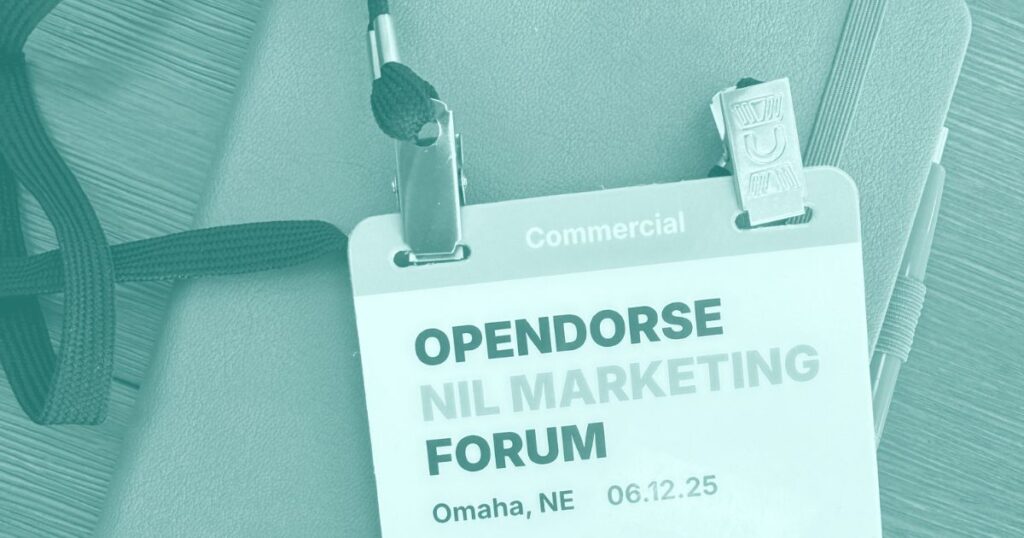The NIL (Name, Image, and Likeness) era continues to evolve and reshape how brands show up online and engage with their audiences. For marketers, it presents one of the most authentic and high-impact opportunities to connect with their audience. After attending the Opendorse NIL Marketing Forum, a first-of-its-kind conference centered on how brands, student-athletes and platforms are navigating the NIL space, we came away with five takeaways for how brands can connect their business goals with the people turning passion into influence.
1. Engagement is the metric that matters most.
Across every panel, one thing was loud and clear: engagement is the real currency, not impressions. Brands like Quest and Hy-Vee are redefining their influencer KPIs by looking at how audiences interact with content — comments, saves and shares matter more than passive reach. Looking at these metrics helps discern which creator (and in this case, student-athlete) is best for their brand, and more clearly defines the metrics that matter to your campaign and business objectives. Influencer marketing traditionally fits within your upper funnel tactics, but that doesn’t mean it isn’t effective. Communicating a clear measure of success will help in getting buy-in from leadership.
What this means for you: When choosing student-athlete influencers, prioritize engagement over follower count and educate leadership on what long-term brand building really looks like online. As Denise Niu, Influencer Marketing Manager from Quest says, “You can’t convert someone if they’re not aware of you.”
2. Student-athlete content is a Masterclass in authenticity and aspiration.
What surprised many of the brand marketers in the room? How expressive and driven these student-athletes are outside of their craft. They’re not just promoting protein bars and electrolyte drinks; they’re building their personal brands. And because their content is deeply rooted in personal identity and pride in their sport, their content often feels more powerful than traditional influencer content. It’s the difference between leveraging influential people, and influencers.
Cami Merickel, Track & Field/Cross Country student-athlete at UNL and one of the panelists, put it best: she feels more successful when brands give her the creative freedom to deliver on-brief content that feels authentic to her, but that she also knows will resonate with her audience.
What this means for you: Trust the creators. Focusing on authentic storytelling versus polished scripts will help bridge the gap between your business objectives and audiences online who are craving authenticity, no matter the generation.
3. Education is part of the NIL-creator partnership.
Working with student-athletes isn’t the same as working with seasoned influencers. Many are self-taught, juggling school, sports and content creation. They often don’t have resources like production teams, lighting and camera equipment or social media managers. While there are always exceptions, brands that assume a student-athlete will deliver turnkey content without support are often left disappointed.
Successful brands are:
- Providing clear briefs and creative direction
- Encouraging open communication channels and honest feedback
- Educating on video editing and social trends
What this means for you: Whether you’re working with creators, employees, or customers as brand advocates, treat them like collaborators, not contractors. Build in time for guidance and learning. Think long-term relationships over one-time content drops.
4. Micro and mid-tier influencers deliver outsized value.
One of the strongest themes was the power of micro- and mid-tier student-athlete influencers, especially for brands just starting in influencer or NIL marketing plans (see also: limited budgets). This means those with a highly engaged niche following, but not necessarily mass fame, might be your sweet spot. Creative executions outside of social media are also worth exploring in this market. Tessa Schlatter, Retail Marketing Coordinator at Hy-Vee is doing things like:
- Localized POS signage, athlete cutouts and interior signage
- Community-focused activations in smaller markets
- UGC-based story series
What this means for you: It can pay to look beyond the starting lineup or the most popular sports. Going this route could mean creators that are more accessible, grateful and connected to their community – which translates into trust and results.
5. Strategic content + smart media = real ROI.
We know that digital marketing today is equal parts creative and operational. That means combining paid media with your organic strategy to ensure you hit campaign reach goals. And because you’re integrating the athlete’s brand with yours, you need to define the level of production you’re looking for in the content; casual, lightly produced or high-production value, and align that with platform best practices. What works on Instagram Reels could be different on TikTok and Stories depending on your objectives and audience.
Don’t sleep on usage rights. If you’re planning to boost athlete content, secure rights upfront, ideally for 3 to 6 months. It enables paid amplification, in-flight optimization, and better CPM efficiency over time.
What this means for you: Treat athlete content (or any influencer content) as a scalable media asset — not just an organic post. Build your plan with platform, tone, timing and licensing in mind.
Final thoughts.
As marketers, we’re always looking for storytelling that cuts through. Working with student-athletes offers raw, ambitious and passion-led content that connects with audiences. But it also requires a shift in how we approach influencer work — more human, more patient and more values-aligned.
Creators (of all kinds) can be your storytellers and your job as a marketer is to equip them, trust them and make sure their stories align with your brand’s purpose.
Looking to integrate creator content into your marketing strategy? We’d love to help!
